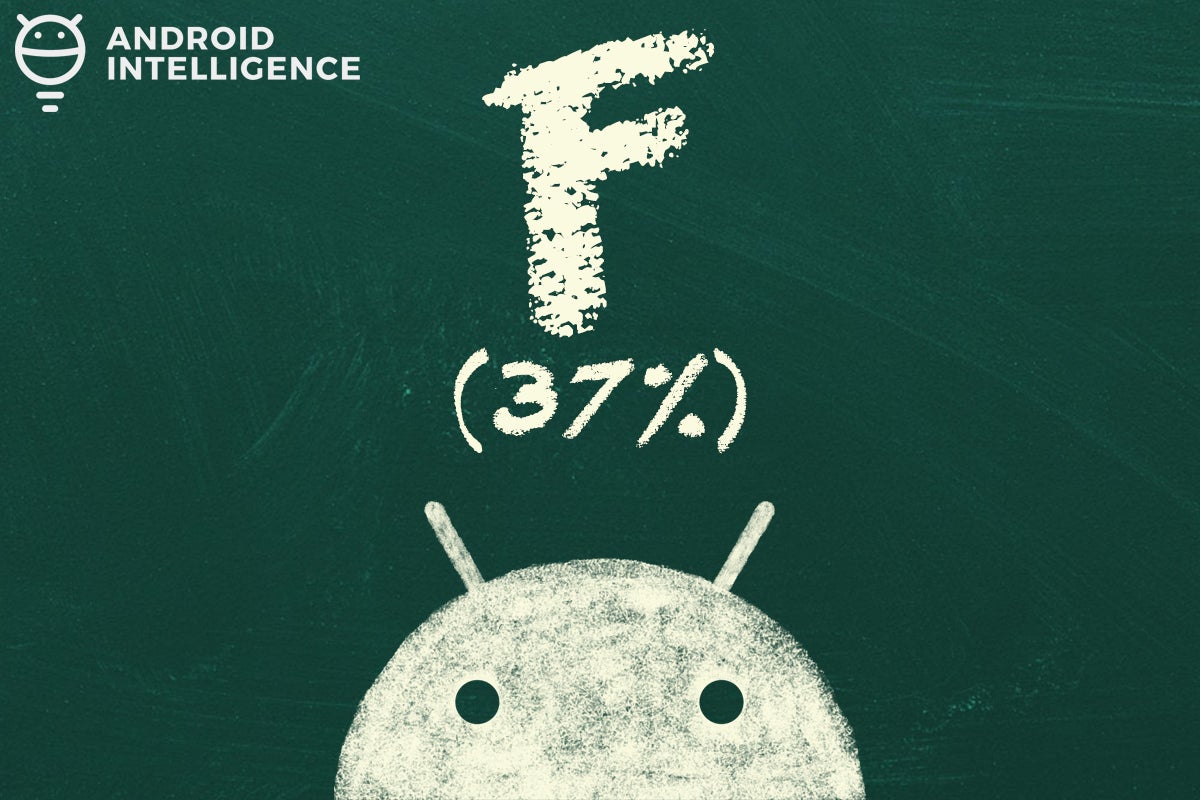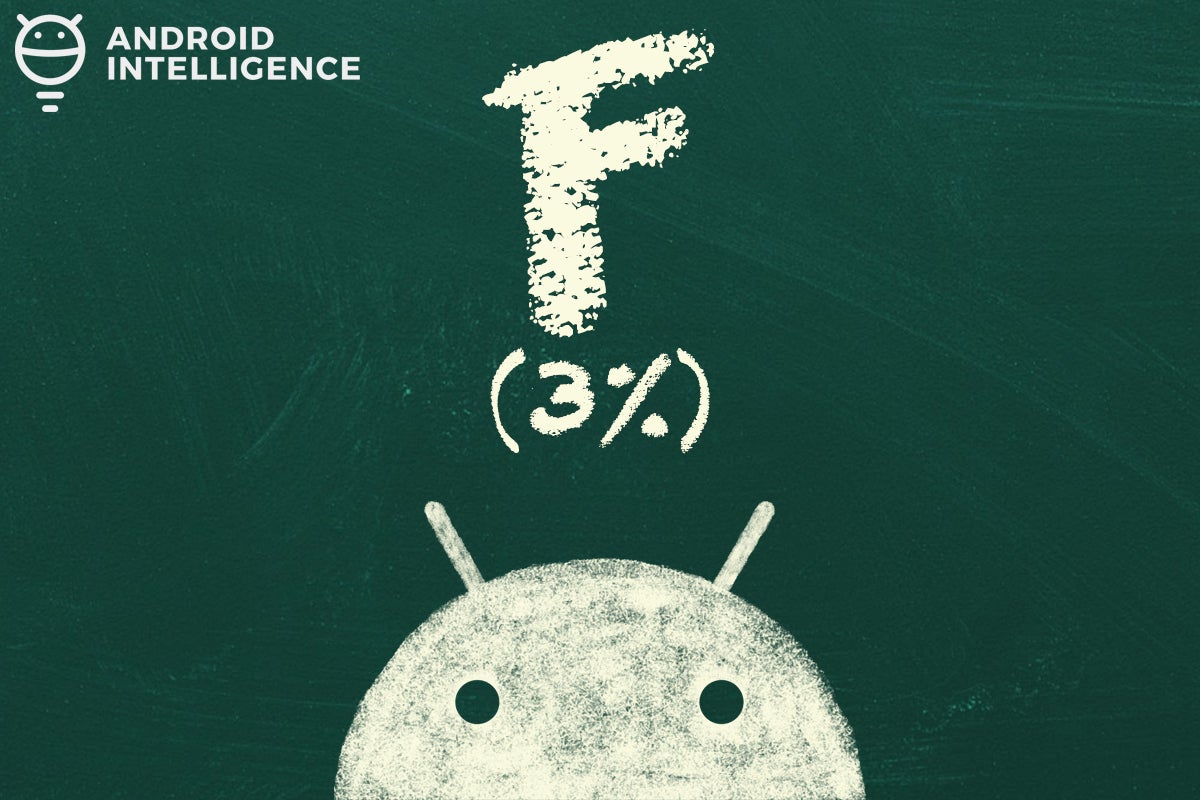LG
 JR
JR - Length of time for upgrade to reach current flagship: 172 days (37/60 points)
- Length of time for upgrade to reach previous-gen flagship: Still waiting (0/30 points)
- Communication: Poor (0/10 points)
I'll be honest: I've mostly run out of things to say about LG at this point. The company has been a blemish on this analysis since pretty much the start — and after a tiny shred of improvement with last year's Android upgrade cycle (one that was enough to get it a record-setting 43% F score — yay?), LG is back to its usual habit of doing next to nothing for the people who shell out hundreds of dollars for its devices.
Between the once-flagship-level G line and the maybe-sorta-kinda alternate flagship V line, it's tough to say for sure which devices are even LG's flagship phones these days, but I'm going ahead and counting the company's single U.S. rollout of Android 11 to its LG V60 ThinQ 5G (gesundheit!) as something. That upgrade happened a mere matter of days ago, though, right before the six-month mark, so it isn't exactly a celebration-worthy win.
Beyond that, the rest of the company's U.S. handsets are still waiting, with nary a peep about any plans or timing expectations moving forward. (And all of that, mind you, is despite the company's comical boasting about its groundbreaking innovations in Android upgrade management a couple years back. Um, right, y'all.)
I'll repeat my now-annual assessment of the situation: If you buy a phone from LG, you're accepting the fact that you'll be waiting in the dark — likely for a very long time — to see if or when you'll ever get any future updates. So you'd better make sure you're okay with that black hole before shelling out your hard-earned money.
Speaking of which...
Motorola (Lenovo)
 JR/Google
JR/Google - Length of time for upgrade to reach current flagship: Still waiting (0/60 points)
- Length of time for upgrade to reach previous-gen flagship: Still waiting (0/30 points)
- Communication: Poor (3/10 points)
Oh, Moto. Moto, Moto, Moto. The company that was once a shining high point of the Android upgrade picture continues to be consistent in its disappointment when it comes to post-sales software support today. As of this moment, Motorola has yet to roll out a single Android 11 upgrade to any phone in the U.S., where this analysis of ours is focused.
It did put out a list of phones it planned to update in late December, just before the holidays and more than three months after Android 11's arrival — albeit with no specific timing info or meaningful promises attached. So that's something, in terms of communication, but just barely.
It's enough to get Motorola a few points, though, leading to that appropriately pitiful-looking 3% F score. So...yeah: Go team?
Wait — what about everyone else?
Notice any names missing from this list? For the first time ever, I've omitted HTC — once the most prominent and enthusiast-beloved company within the Android ecosystem — from this analysis. After years of exemplary software support, HTC had fallen pretty hard as of late, earning an unfortunate 0% F grade in last year's report card and similarly sad F scores in the couple years before that.
Well, we've reached a point now where HTC is barely even putting out new phones anymore — certainly not flagship-level devices. And so there's really nothing to assess. If HTC comes back around and attempts to get in the game again at any point, I'll eagerly add it back into the list for inclusion.
And then there's Sony — a company a random reader will ask me about on occasion but that just doesn't make sense to include in this list right now. Sony has never had much of a meaningful presence in the U.S. smartphone market (which is a shame, really — but that's another story for another time), and in recent years, its role has dropped from "barely anything" to "virtually nothing."
I can't even begin to make head or tails of Sony's convoluted, confusingly named phone lineup anymore, but the company sent its first Android 11 upgrade out in mid-December — just over three months after the software's release — and then sent updates to a handful of other devices about a month after that. Its communication efforts are consistently better than most, too. It certainly wouldn't be topping the list if it were included in this analysis, but it'd be a much-needed extra addition to the middle-of-the-pack, C-range section and something to better take us from our first-place A ranking to the second-place D-level score.
And then there's Nokia. That company has an extremely limited presence in the U.S., but it's generally done a solid job of keeping its phones updated with both major and minor OS releases and with monthly security patches since it entered the Android arena a handful of years back. At least, that was the case — up until now.
Despite the fact that Nokia now makes all of its phones part of Android One — a Google-run program that includes an assurance of reasonably timely (if not Pixel-level) ongoing software updates — the company mostly dropped the ball this upgrade cycle, with a single sluggish update just weeks ago and the rest of its rollouts curiously still pending. Especially with the Android One connection, that raises some tricky questions not only about what's happening within Nokia itself but also what's happening with the state of that once-reliable Google-associated program.
Want even more Googley knowledge? Sign up for my weekly newsletter to get next-level tips and insight delivered directly to your inbox.
In detail: How these grades were calculated
This report card follows the same grading system used with previous years' analyses — which features precise and clearly defined standards designed to weigh performance for both current and previous-generation flagship phones along with a company's communication efforts, all in a consistent manner.
Each manufacturer's overall grade is based on the following formula, with final scores being rounded up or down to the nearest full integer:
- 60% of grade: Length of time for upgrade to reach current flagship phone(s)
- 30% of grade: Length of time for upgrade to reach previous-gen flagship phone(s)
- 10% of grade: Overall communication with customers throughout the upgrade process
Upgrade timing often varies wildly from one country or carrier to the next, so in order to create a consistent standard for scoring, I've focused this analysis on when Android 11 first reached a flagship model that's readily available in the U.S. — either a carrier-connected model or an unlocked version of the phone, if such a product is sold by the manufacturer and readily available to U.S. customers — in a public, official, and not opt-in-beta-oriented over-the-air rollout.
(To be clear, I'm not counting being able to import an international version of a phone from eBay or from some random seller on Amazon as being "readily available to U.S. customers." For the purposes of creating a reasonable and consistent standard for this analysis, a phone has to be sold in the U.S. in some official capacity in order to be considered a "U.S. model" of a device. I also don't include Android One devices as part of this analysis, as (a) they're part of a separate program that has contract-based requirements for upgrade delivery timing — at least in theory — and (b) they rely on Google's Android software instead of a company's own take on the operating system. Consequently, those devices are anomalies in a company's broader profile; they exist in a category of their own and aren't indicative of a device-maker's upgrade behavior with its own self-controlled flagships.)
By looking at the time to Android 11's first appearance (via an over-the-air rollout) on a device in the U.S., we're measuring how quickly a typical U.S. device-owner could realistically get the software in a normal situation. And since we're looking at the first appearance, in any unlocked or carrier-connected phone, we're eliminating any carrier-specific delays from the equation and focusing purely on the soonest possible window you could receive an update from any given manufacturer in this country. We're also eliminating the PR-focused silliness of a manufacturer rushing to roll out a small-scale upgrade in somewhere like Lithuania just so they can put out a press release touting that they were "FIRST," when the practical implication of such a rollout is basically just a rounding error. I chose to focus on the U.S. specifically because that's where this publication (and this person writing this right now — hi!) is based, but this same analysis could be done using any country as its basis, of course, and the results would vary accordingly.
All measurements start from the day Android 11 was released into the Android Open Source Project: September 8, 2020, which is when the final raw OS code finished uploading and became available to manufacturers.
The following scale determined each manufacturer's subscores for upgrade timeliness:
- 1-14 days to first U.S. rollout = A+ (100)
- 15-30 days to first U.S. rollout = A (96)
- 31-45 days to first U.S. rollout = A- (92)
- 46-60 days to first U.S. rollout = B+ (89)
- 61-75 days to first U.S. rollout = B (86)
- 76-90 days to first U.S. rollout = B- (82)
- 91-105 days to first U.S. rollout = C+ (79)
- 106-120 days to first U.S. rollout = C (76)
- 121-135 days to first U.S. rollout = C- (72)
- 136-150 days to first U.S. rollout = D+ (69)
- 151-165 days to first U.S. rollout = D (66)
- 166-180 days to first U.S. rollout = D- (62)
- More than 180 days to first U.S. rollout (and thus no upgrade activity within the six-month window) = F (0)
There's just one asterisk: If a manufacturer outright abandons any U.S.-relevant models of a device, its score defaults to zero for that specific category. Within that category (be it current or previous-gen flagship), such behavior is an indication that the manufacturer in question could not be trusted to honor its commitment and provide an upgrade. This adjustment allows the score to better reflect that reality. (No such adjustments were made this year, though there have been instances where it's happened in the past.)
Last but not least, this analysis focuses on manufacturers selling flagship phones that are relevant and in some way significant to the U.S. market and/or the Android enthusiast community. That, as I alluded to above, is why someone like Sony is no longer part of the primary analysis — and why companies like Xiaomi and Huawei are not presently part of this picture, despite their relevance in other parts of the world. Considering the performance of players in a market such as China would certainly be interesting, but it'd be a completely different and totally separate analysis, and it's beyond the scope of what we're considering in this one report.
Aside from the companies included here, most players are either still relatively insignificant in the U.S. market or have focused their efforts more on the budget realm in the States so far — and thus don't make sense, at least as of now, to include in this specific-sample-oriented and flagship-focused breakdown.





